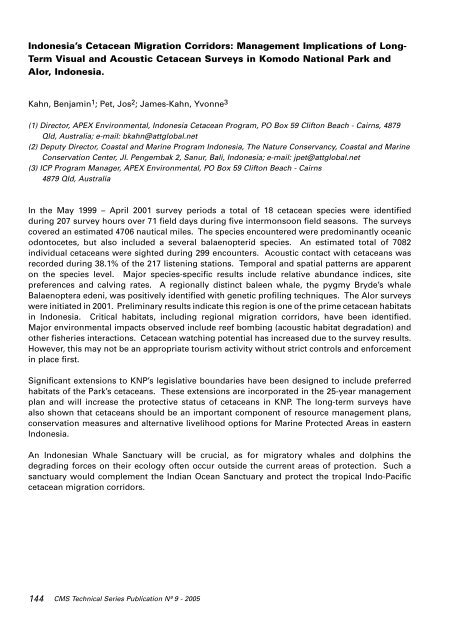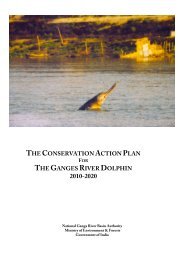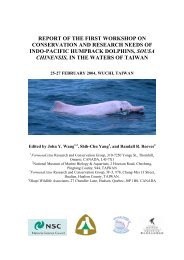Abundance <strong>and</strong> Trends in Size <str<strong>on</strong>g>of</str<strong>on</strong>g> <str<strong>on</strong>g>the</str<strong>on</strong>g> Indo-Pacific Humpback DolphinPopulati<strong>on</strong> in <str<strong>on</strong>g>the</str<strong>on</strong>g> Pearl River Estuary, P.R. ChinaJeffers<strong>on</strong>, Thomas A. 1,2 ; Hung, Samuel K. 2 ; Qiu, Y<strong>on</strong>g-S<strong>on</strong>g 3(1) Southwest Fisheries Science Center, NOAA, NMFS, P.O. Box 271, La Jolla, CA 92038 USA(2) H<strong>on</strong>g K<strong>on</strong>g Cetacean Research Project, P.O. Box 28598, Gloucester Road Post Office,Wanchai, H<strong>on</strong>g K<strong>on</strong>g(3) South China Sea Fisheries Institute, CAFS, Guangzhou 510300, P.R. ChinaLine transect surveys using 12-15 m vessels have been c<strong>on</strong>ducted since late 1995 to estimate <str<strong>on</strong>g>the</str<strong>on</strong>g>abundance <strong>and</strong> populati<strong>on</strong> trends <str<strong>on</strong>g>of</str<strong>on</strong>g> Indo-Pacific humpback dolphins (Sousa chinensis) in H<strong>on</strong>gK<strong>on</strong>g <strong>and</strong> adjacent waters <str<strong>on</strong>g>of</str<strong>on</strong>g> China’s Pearl River Estuary (an area <str<strong>on</strong>g>of</str<strong>on</strong>g> 3,856 km2). Distributi<strong>on</strong>patterns, as well as data from photo-identificati<strong>on</strong> <strong>and</strong> molecular genetic studies, indicate thata single populati<strong>on</strong> inhabits this area. We used 43,376 km <str<strong>on</strong>g>of</str<strong>on</strong>g> sighting effort collected duringc<strong>on</strong>diti<strong>on</strong>s <str<strong>on</strong>g>of</str<strong>on</strong>g> Beaufort 3 or lower, al<strong>on</strong>g with 1,673 <strong>on</strong>-effort sightings, to estimate abundance innine survey areas in which dolphins were sighted. All <str<strong>on</strong>g>of</str<strong>on</strong>g> <str<strong>on</strong>g>the</str<strong>on</strong>g> areas with dolphin sightings wereinfluenced to varying degrees by freshwater discharge from <str<strong>on</strong>g>the</str<strong>on</strong>g> Pearl River. Four o<str<strong>on</strong>g>the</str<strong>on</strong>g>r areasin H<strong>on</strong>g K<strong>on</strong>g’s eastern waters with little or no influence from <str<strong>on</strong>g>the</str<strong>on</strong>g> Pearl River had no dolphinsightings. <strong>The</strong>re were seas<strong>on</strong>al fluctuati<strong>on</strong>s in <str<strong>on</strong>g>the</str<strong>on</strong>g> densities <str<strong>on</strong>g>of</str<strong>on</strong>g> dolphins in different areas. <strong>The</strong>highest total <str<strong>on</strong>g>of</str<strong>on</strong>g> <str<strong>on</strong>g>the</str<strong>on</strong>g> estimates for any <strong>on</strong>e seas<strong>on</strong> was 1,383 dolphins in winter. This represents aminimum estimate <str<strong>on</strong>g>of</str<strong>on</strong>g> total populati<strong>on</strong> size. Mark-recapture analysis <str<strong>on</strong>g>of</str<strong>on</strong>g> photo-identificati<strong>on</strong> dataprovided an alternative populati<strong>on</strong> size estimate <str<strong>on</strong>g>of</str<strong>on</strong>g> 753 dolphins, but we believe that this is anunderestimate. We also examined trends in abundance in North Lantau. Line transect estimateswere made for 12 6-m<strong>on</strong>th periods, <strong>and</strong> <str<strong>on</strong>g>the</str<strong>on</strong>g> resulting pattern was for a decline from <str<strong>on</strong>g>the</str<strong>on</strong>g> start <str<strong>on</strong>g>of</str<strong>on</strong>g><str<strong>on</strong>g>the</str<strong>on</strong>g> study until summer/autumn 1998, <strong>and</strong> an increasing trend since <str<strong>on</strong>g>the</str<strong>on</strong>g>n. <strong>The</strong> apparent reversalin <str<strong>on</strong>g>the</str<strong>on</strong>g> trend occurred at about <str<strong>on</strong>g>the</str<strong>on</strong>g> time <str<strong>on</strong>g>of</str<strong>on</strong>g> <str<strong>on</strong>g>the</str<strong>on</strong>g> opening <str<strong>on</strong>g>of</str<strong>on</strong>g> H<strong>on</strong>g K<strong>on</strong>g’s new internati<strong>on</strong>al airport.<strong>The</strong> trends analysis could suggest that <str<strong>on</strong>g>the</str<strong>on</strong>g> populati<strong>on</strong> is increasing, or at least stable, but <str<strong>on</strong>g>the</str<strong>on</strong>g>reis uncertainty due to <str<strong>on</strong>g>the</str<strong>on</strong>g> potential for animals to have moved into <strong>and</strong> out <str<strong>on</strong>g>of</str<strong>on</strong>g> <str<strong>on</strong>g>the</str<strong>on</strong>g> trends studyarea.<str<strong>on</strong>g>Sec<strong>on</strong>d</str<strong>on</strong>g> <str<strong>on</strong>g>Workshop</str<strong>on</strong>g> <strong>on</strong> <str<strong>on</strong>g>the</str<strong>on</strong>g> <strong>Biology</strong> <strong>and</strong> C<strong>on</strong>servati<strong>on</strong> <str<strong>on</strong>g>of</str<strong>on</strong>g> Small Cetaceans <strong>and</strong> Dug<strong>on</strong>gs <str<strong>on</strong>g>of</str<strong>on</strong>g> SE Asia 143
Ind<strong>on</strong>esia’s Cetacean Migrati<strong>on</strong> Corridors: Management Implicati<strong>on</strong>s <str<strong>on</strong>g>of</str<strong>on</strong>g> L<strong>on</strong>g-Term Visual <strong>and</strong> Acoustic Cetacean Surveys in Komodo Nati<strong>on</strong>al Park <strong>and</strong>Alor, Ind<strong>on</strong>esia.Kahn, Benjamin 1 ; Pet, Jos 2 ; James-Kahn, Yv<strong>on</strong>ne 3(1) Director, APEX Envir<strong>on</strong>mental, Ind<strong>on</strong>esia Cetacean Program, PO Box 59 Clift<strong>on</strong> Beach - Cairns, 4879Qld, Australia; e-mail: bkahn@attglobal.net(2) Deputy Director, Coastal <strong>and</strong> Marine Program Ind<strong>on</strong>esia, <strong>The</strong> Nature C<strong>on</strong>servancy, Coastal <strong>and</strong> MarineC<strong>on</strong>servati<strong>on</strong> Center, Jl. Pengembak 2, Sanur, Bali, Ind<strong>on</strong>esia; e-mail: jpet@attglobal.net(3) ICP Program Manager, APEX Envir<strong>on</strong>mental, PO Box 59 Clift<strong>on</strong> Beach - Cairns4879 Qld, AustraliaIn <str<strong>on</strong>g>the</str<strong>on</strong>g> May 1999 – April 2001 survey periods a total <str<strong>on</strong>g>of</str<strong>on</strong>g> 18 cetacean species were identifiedduring 207 survey hours over 71 field days during five interm<strong>on</strong>so<strong>on</strong> field seas<strong>on</strong>s. <strong>The</strong> surveyscovered an estimated 4706 nautical miles. <strong>The</strong> species encountered were predominantly oceanicod<strong>on</strong>tocetes, but also included a several balaenopterid species. An estimated total <str<strong>on</strong>g>of</str<strong>on</strong>g> 7082individual cetaceans were sighted during 299 encounters. Acoustic c<strong>on</strong>tact with cetaceans wasrecorded during 38.1% <str<strong>on</strong>g>of</str<strong>on</strong>g> <str<strong>on</strong>g>the</str<strong>on</strong>g> 217 listening stati<strong>on</strong>s. Temporal <strong>and</strong> spatial patterns are apparent<strong>on</strong> <str<strong>on</strong>g>the</str<strong>on</strong>g> species level. Major species-specific results include relative abundance indices, sitepreferences <strong>and</strong> calving rates. A regi<strong>on</strong>ally distinct baleen whale, <str<strong>on</strong>g>the</str<strong>on</strong>g> pygmy Bryde’s whaleBalaenoptera edeni, was positively identified with genetic pr<str<strong>on</strong>g>of</str<strong>on</strong>g>iling techniques. <strong>The</strong> Alor surveyswere initiated in 2001. Preliminary results indicate this regi<strong>on</strong> is <strong>on</strong>e <str<strong>on</strong>g>of</str<strong>on</strong>g> <str<strong>on</strong>g>the</str<strong>on</strong>g> prime cetacean habitatsin Ind<strong>on</strong>esia. Critical habitats, including regi<strong>on</strong>al migrati<strong>on</strong> corridors, have been identified.Major envir<strong>on</strong>mental impacts observed include reef bombing (acoustic habitat degradati<strong>on</strong>) <strong>and</strong>o<str<strong>on</strong>g>the</str<strong>on</strong>g>r fisheries interacti<strong>on</strong>s. Cetacean watching potential has increased due to <str<strong>on</strong>g>the</str<strong>on</strong>g> survey results.However, this may not be an appropriate tourism activity without strict c<strong>on</strong>trols <strong>and</strong> enforcementin place first.Significant extensi<strong>on</strong>s to KNP’s legislative boundaries have been designed to include preferredhabitats <str<strong>on</strong>g>of</str<strong>on</strong>g> <str<strong>on</strong>g>the</str<strong>on</strong>g> Park’s cetaceans. <strong>The</strong>se extensi<strong>on</strong>s are incorporated in <str<strong>on</strong>g>the</str<strong>on</strong>g> 25-year managementplan <strong>and</strong> will increase <str<strong>on</strong>g>the</str<strong>on</strong>g> protective status <str<strong>on</strong>g>of</str<strong>on</strong>g> cetaceans in KNP. <strong>The</strong> l<strong>on</strong>g-term surveys havealso shown that cetaceans should be an important comp<strong>on</strong>ent <str<strong>on</strong>g>of</str<strong>on</strong>g> resource management plans,c<strong>on</strong>servati<strong>on</strong> measures <strong>and</strong> alternative livelihood opti<strong>on</strong>s for Marine Protected Areas in easternInd<strong>on</strong>esia.An Ind<strong>on</strong>esian Whale Sanctuary will be crucial, as for migratory whales <strong>and</strong> dolphins <str<strong>on</strong>g>the</str<strong>on</strong>g>degrading forces <strong>on</strong> <str<strong>on</strong>g>the</str<strong>on</strong>g>ir ecology <str<strong>on</strong>g>of</str<strong>on</strong>g>ten occur outside <str<strong>on</strong>g>the</str<strong>on</strong>g> current areas <str<strong>on</strong>g>of</str<strong>on</strong>g> protecti<strong>on</strong>. Such asanctuary would complement <str<strong>on</strong>g>the</str<strong>on</strong>g> Indian Ocean Sanctuary <strong>and</strong> protect <str<strong>on</strong>g>the</str<strong>on</strong>g> tropical Indo-Pacificcetacean migrati<strong>on</strong> corridors.144 CMS Technical Series Publicati<strong>on</strong> Nº 9 - 2005
- Page 1 and 2:
CMS Technical Series Publication N
- Page 3 and 4:
Published by the U
- Page 5 and 6:
TABLE OF CONTENTSpage1. Preliminari
- Page 7 and 8:
AppendicesAppendix 1 - List <strong
- Page 9 and 10:
8 CMS Technical Series Publication
- Page 11 and 12:
10 CMS Technical Series Publication
- Page 13 and 14:
The cetacean species reviewed inclu
- Page 15 and 16:
Table 1. Major commercial Commonwea
- Page 17 and 18:
(2) State Legislation.In state wate
- Page 19 and 20:
(2) Identification of</stro
- Page 21 and 22:
Coastal speciesThe most frequently
- Page 23 and 24:
Coastal speciesThere are currently
- Page 25 and 26:
and Guangxi Provinces (Yang et al.
- Page 27 and 28:
Table 3. Records of</strong
- Page 29 and 30:
can be viewed as the</stron
- Page 31 and 32:
Workshop participa
- Page 33 and 34:
ioaccumulation have not yet been ex
- Page 35 and 36:
of fishermen who h
- Page 37 and 38:
are supplied to scholars and organi
- Page 39 and 40:
threats. Many marine mammal populat
- Page 42:
waters or recognize important inter
- Page 47 and 48:
James Cook University (Queensland,
- Page 49 and 50:
the last ten years
- Page 51 and 52:
proactive in engaging more staff an
- Page 53 and 54:
of SE Asia. Two sp
- Page 55 and 56:
San Francisco (Negros Oriental); Li
- Page 57 and 58:
Legal status and present management
- Page 59 and 60:
within 15 kilometers from t
- Page 61 and 62:
US, has actively participated in ce
- Page 63 and 64:
the project was su
- Page 65 and 66:
Recently, the camp
- Page 67 and 68:
Mekong River downstream of<
- Page 69 and 70:
porpoises in tropical waters <stron
- Page 71 and 72:
species in the Ind
- Page 73 and 74:
Population/stock structureNo new in
- Page 75 and 76:
Needs for additional researchStock
- Page 77 and 78:
waters of SE Asia,
- Page 79 and 80:
caused mortality is certainly large
- Page 81 and 82:
Needs for additional researchProper
- Page 83 and 84:
from SE Asia, it is known to occur
- Page 85 and 86:
3.1.7 AustraliaDugongs occur all al
- Page 87 and 88:
Table 8. Conservation objectives id
- Page 89 and 90:
3) Monitoring and assessment <stron
- Page 91 and 92:
Table 10. Outline of</stron
- Page 93 and 94: The group agreed that this set <str
- Page 95 and 96: 6. SUMMARY AND CONCLUSIONSThe works
- Page 97 and 98: 96 CMS Technical Series Publication
- Page 99 and 100: Bank, E. 1931. A popular account <s
- Page 101 and 102: Dalebout, M. L., J. G. Mead, C. Sco
- Page 103 and 104: Jaaman, S. A., E. Tangon, I. Isnain
- Page 105 and 106: Lin, Y.-J. 1997. Mitochondrial DNA
- Page 107 and 108: Smith, B.D., T. A. Jefferson, D. Ho
- Page 109 and 110: Yang, W.-C. 2000. Morbillivirus inf
- Page 111 and 112: CHOU Lien-SiangDepartment o
- Page 113 and 114: Brian D. SMITHWildlife Conservation
- Page 115 and 116: APPENDIX 3Agenda1. Preliminaries2.
- Page 117 and 118: Doc. 22 Dugong conservation activit
- Page 119 and 120: AreaDatesSurveyTypeEffortSpeciesNo.
- Page 121 and 122: AreaDatesSurveyTypeEffortSpeciesNo.
- Page 123 and 124: AreaDatesSurveyTypeEffortSpeciesNo.
- Page 125 and 126: Phase ofActionPlan
- Page 127 and 128: [Small cetaceans are defined to inc
- Page 129 and 130: f) recognizing that by-catch in fis
- Page 131 and 132: 130 CMS Technical Series Publicatio
- Page 133 and 134: APPENDIX 9Abstracts of</str
- Page 135 and 136: The (IUCN Critically Endangered) Du
- Page 137 and 138: Status of
- Page 139 and 140: Cetacean Habitats in the</s
- Page 141 and 142: Conservation of <s
- Page 143: Summary of Current
- Page 147 and 148: Conservation Effort to Protect <str
- Page 149 and 150: The Status of <str
- Page 151 and 152: Can the Developing
- Page 153 and 154: Status and Conservation of<
- Page 155 and 156: Legal Hunting of C
- Page 157 and 158: Indo-Pacific Bottlenose Dolphins (T
- Page 159 and 160: Feasibility Study of</stron
- Page 161 and 162: Songs of a Humpbac





